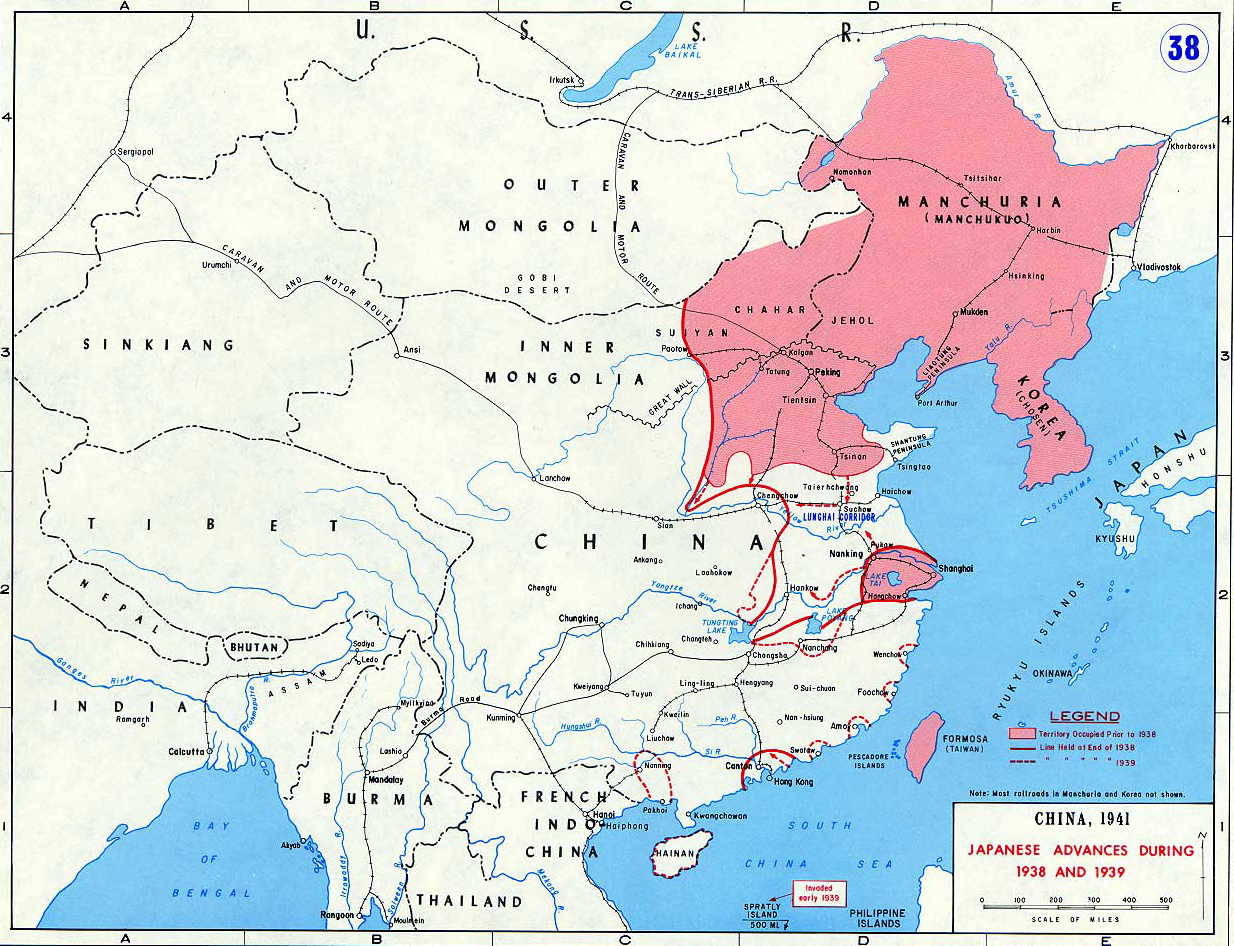Map Description
History Map of China 1938/39
Illustrating Japanese Advances in China During 1938 and 1939
- Territory Occupied Prior to 1938
- Line Held at End of 1938
- Line Held at End of 1939
:: Pre-1938 Gains ::
Prior to 1938, Japanese forces had already achieved significant territorial gains in China following the outbreak of the
Second Sino-Japanese War in 1937. By the end of that year, they had secured control over key urban and coastal centers,
including Manchuria (occupied since 1931), Beijing, Tianjin, Shanghai, and the Nationalist capital of Nanjing, which
fell in December 1937 after a brutal campaign marked by the infamous Nanjing Massacre.
Japanese advances had also extended into northern and central provinces such as Hebei, Shanxi, and parts of Jiangsu and Anhui.
:: 1938 Campaigns ::
Throughout 1938, Japan continued its aggressive expansion into central China. Major campaigns included the capture of
Xuzhou in May following protracted fighting, and the subsequent advance into the strategic Wuhan area, culminating
in the fall of Wuhan in October. This marked the peak of Japan’s large-scale conventional offensives.
By the end of 1938, the Japanese held a continuous front stretching from southern Manchuria through northern China
and into central regions, including much of the Yangtze River valley. However, they faced stiff resistance and
guerrilla warfare from Chinese forces, and their control was often limited to urban centers and railway lines, with rural
areas remaining contested.
:: 1939 Stalemate ::
In 1939, Japanese territorial gains slowed significantly, and the front lines largely stabilized. The Japanese military
launched several smaller offensives in northern and southeastern China, such as
the Battle of Nanchang in early 1939
and operations in Hunan and Guangxi provinces, aimed at consolidating and extending control. Despite these efforts,
no major new strategic breakthroughs were achieved.
By the end of 1939, the Japanese held much of eastern China,
including key railways and cities, but were unable to decisively defeat the Chinese Nationalist government or suppress
widespread resistance. The conflict settled into a protracted war of attrition, with front lines remaining relatively
static and Japan increasingly strained by logistical challenges and guerrilla warfare in occupied areas.
:: Soviet-Japanese War of 1939 ::
In the D 4 square on this map, you will find Nomonhan. The frequently overlooked Battle of Nomonhan / Khalkhin Gol
was fought from May 11,
1939 until September 16, 1939. In total, between 100,000 to 120,000 troops were involved.
Total deaths were likely between 17,000 to 30,000 across both sides.
This conflict fundamentally altered World War II's trajectory by reshaping both Japanese and Soviet strategic decisions:
Japan's defeat compelled them to abandon northern expansion against the USSR and redirect their imperial ambitions
southward, eventually culminating in the Pearl Harbor attack and war with America. For the Soviets, this victory secured
their eastern flank, allowing Stalin to concentrate on Poland following the Molotov-Ribbentrop Pact with Nazi Germany. When
Hitler invaded the Soviet Union in 1941, Japan — still reeling from their Khalkhin Gol losses — declined to join the attack
despite German pressure, thereby sparing the USSR from fighting on two fronts and significantly influencing the war's outcome.
Credits
Courtesy of the United States Military Academy Department of History.
Related Links
About the Second Sino-Japanese WarAbout World War 2
WWII Timelines
Governments of China

